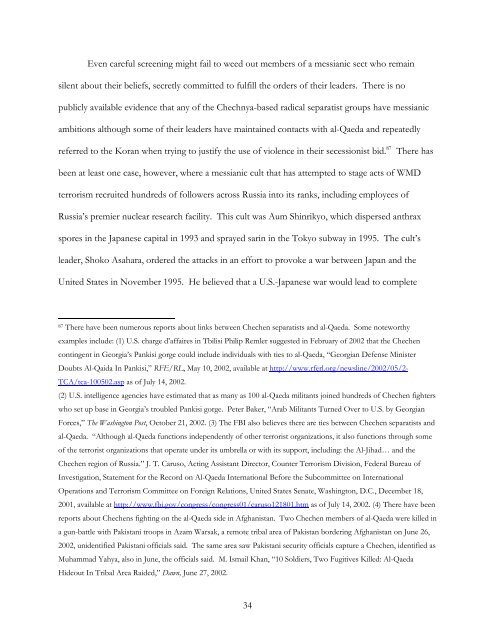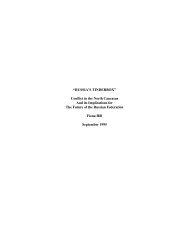Russia - Belfer Center for Science and International Affairs - Harvard ...
Russia - Belfer Center for Science and International Affairs - Harvard ...
Russia - Belfer Center for Science and International Affairs - Harvard ...
Create successful ePaper yourself
Turn your PDF publications into a flip-book with our unique Google optimized e-Paper software.
Even careful screening might fail to weed out members of a messianic sect who remain<br />
silent about their beliefs, secretly committed to fulfill the orders of their leaders. There is no<br />
publicly available evidence that any of the Chechnya-based radical separatist groups have messianic<br />
ambitions although some of their leaders have maintained contacts with al-Qaeda <strong>and</strong> repeatedly<br />
referred to the Koran when trying to justify the use of violence in their secessionist bid. 87 There has<br />
been at least one case, however, where a messianic cult that has attempted to stage acts of WMD<br />
terrorism recruited hundreds of followers across <strong>Russia</strong> into its ranks, including employees of<br />
<strong>Russia</strong>’s premier nuclear research facility. This cult was Aum Shinrikyo, which dispersed anthrax<br />
spores in the Japanese capital in 1993 <strong>and</strong> sprayed sarin in the Tokyo subway in 1995. The cult’s<br />
leader, Shoko Asahara, ordered the attacks in an ef<strong>for</strong>t to provoke a war between Japan <strong>and</strong> the<br />
United States in November 1995. He believed that a U.S.-Japanese war would lead to complete<br />
87 There have been numerous reports about links between Chechen separatists <strong>and</strong> al-Qaeda. Some noteworthy<br />
examples include: (1) U.S. charge d’affaires in Tbilisi Philip Remler suggested in February of 2002 that the Chechen<br />
contingent in Georgia’s Pankisi gorge could include individuals with ties to al-Qaeda, “Georgian Defense Minister<br />
Doubts Al-Qaida In Pankisi,” RFE/RL, May 10, 2002, available at http://www.rferl.org/newsline/2002/05/2-<br />
TCA/tca-100502.asp as of July 14, 2002.<br />
(2) U.S. intelligence agencies have estimated that as many as 100 al-Qaeda militants joined hundreds of Chechen fighters<br />
who set up base in Georgia’s troubled Pankisi gorge. Peter Baker, “Arab Militants Turned Over to U.S. by Georgian<br />
Forces,” The Washington Post, October 21, 2002. (3) The FBI also believes there are ties between Chechen separatists <strong>and</strong><br />
al-Qaeda. “Although al-Qaeda functions independently of other terrorist organizations, it also functions through some<br />
of the terrorist organizations that operate under its umbrella or with its support, including: the Al-Jihad… <strong>and</strong> the<br />
Chechen region of <strong>Russia</strong>.” J. T. Caruso, Acting Assistant Director, Counter Terrorism Division, Federal Bureau of<br />
Investigation, Statement <strong>for</strong> the Record on Al-Qaeda <strong>International</strong> Be<strong>for</strong>e the Subcommittee on <strong>International</strong><br />
Operations <strong>and</strong> Terrorism Committee on Foreign Relations, United States Senate, Washington, D.C., December 18,<br />
2001, available at http://www.fbi.gov/congress/congress01/caruso121801.htm as of July 14, 2002. (4) There have been<br />
reports about Chechens fighting on the al-Qaeda side in Afghanistan. Two Chechen members of al-Qaeda were killed in<br />
a gun-battle with Pakistani troops in Azam Warsak, a remote tribal area of Pakistan bordering Afghanistan on June 26,<br />
2002, unidentified Pakistani officials said. The same area saw Pakistani security officials capture a Chechen, identified as<br />
Muhammad Yahya, also in June, the officials said. M. Ismail Khan, “10 Soldiers, Two Fugitives Killed: Al-Qaeda<br />
Hideout In Tribal Area Raided,” Dawn, June 27, 2002.<br />
34
















